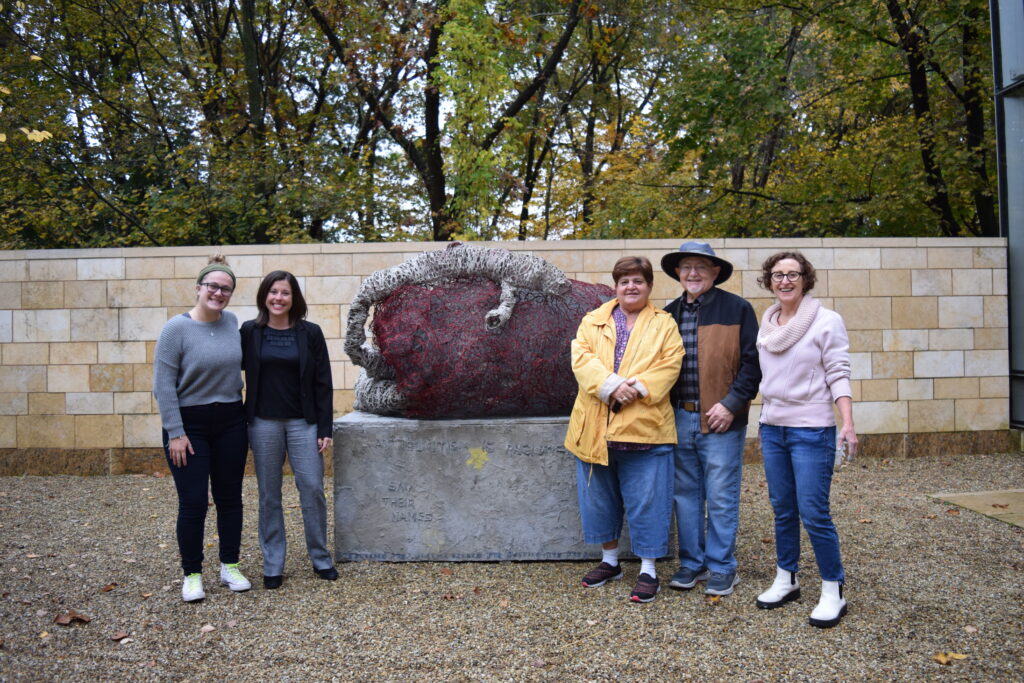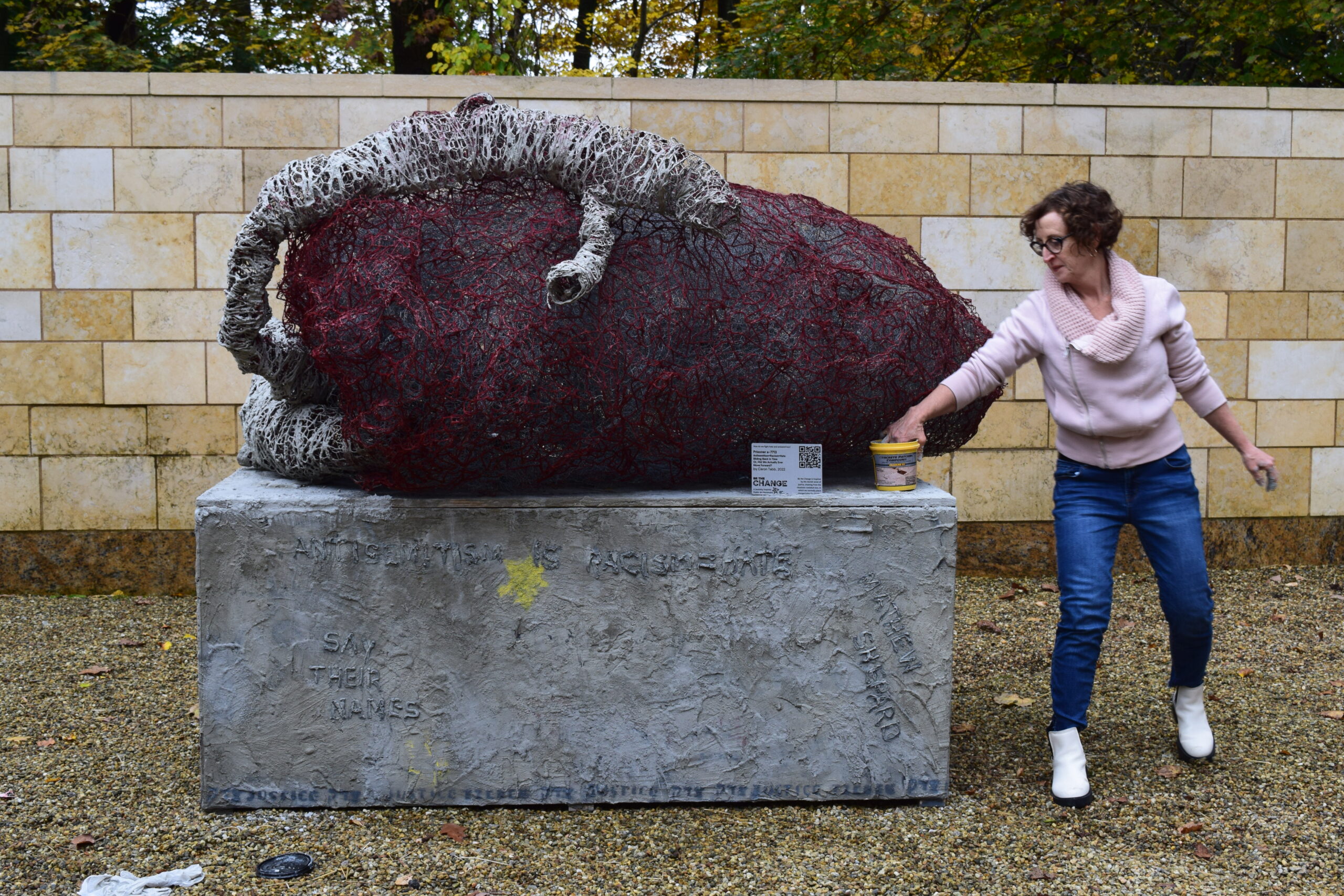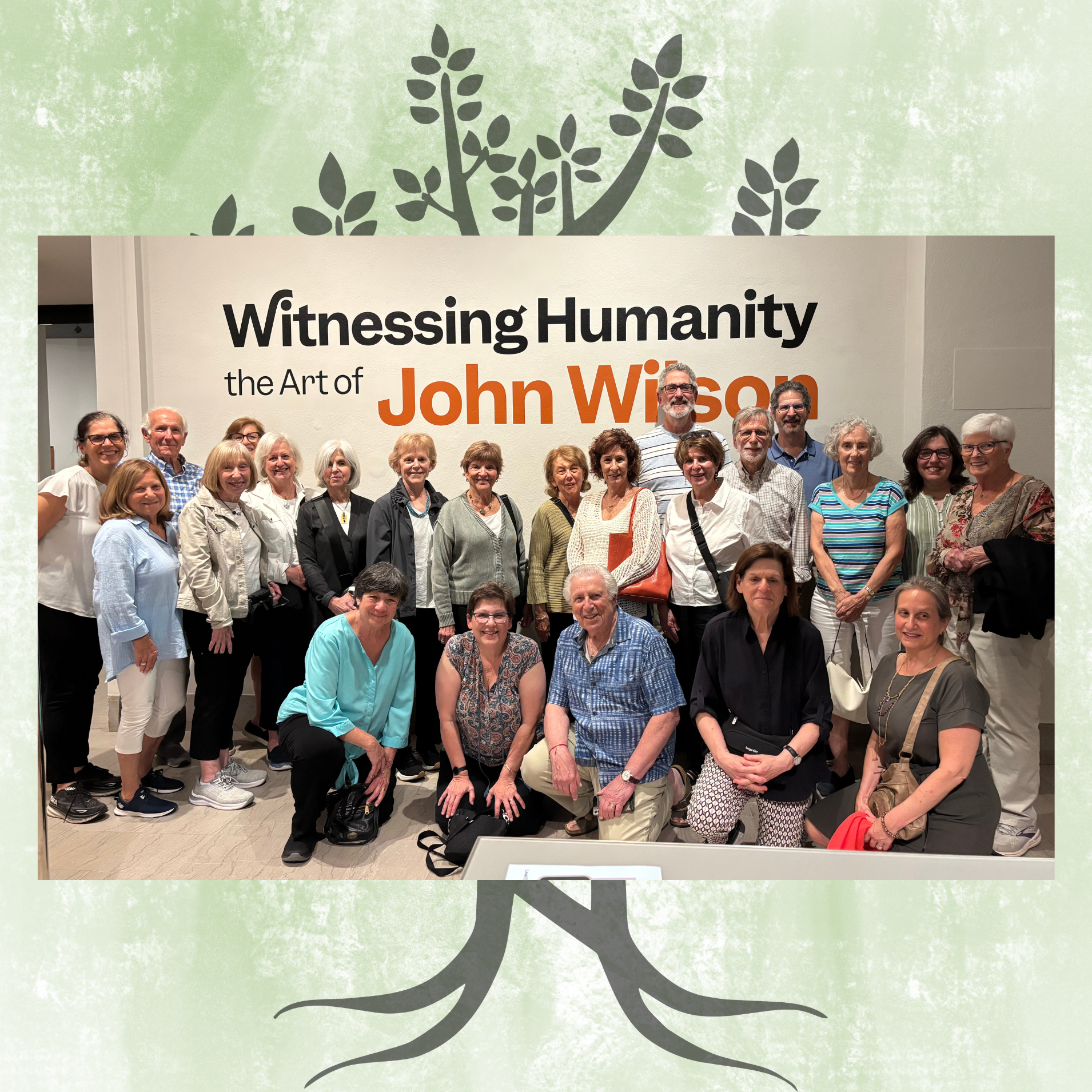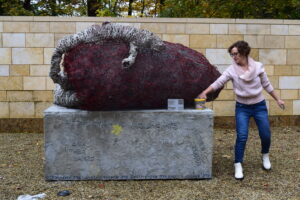
Caron Tabb’s Be the Change sculpture, “Prisoner a-7713: Antisemitism = Racism = Hate. Sliding Back in Time Or, Did We Actually Ever Move Forward?” was installed in the TBE courtyard, with many thanks to a gift from Diane and Gary Glick and JArts. We interviewed Caron to learn more about her sculpture, the Be the Change Project, and her work as an artivist.
TBE
Let’s start at the beginning by asking about the title. How did you pick the title, and how do you see it working in concert with the art itself?
Caron Tabb
This idea for Be the Change came from the tzedakah boxes in my shows, and this idea that art can connect us to issues that are larger than us and can engage people in conversation around difficult topics. When I was thinking about what I was going to pick for my piece of art, I felt that I needed to pick something that was very authentic. I could have picked gun violence, I could have picked homelessness, I could have picked a lot of different topics that I care about deeply. I have something to say about them, but it felt as if I wasn’t being authentic to both my voice and my art if I picked something that wasn’t about my experience. So that led me to think that I needed to see what was going on with my community. What were the challenges that my community was facing? And the issue of antisemitism came up in the most profound way. So I knew at that point that that was going to be my focus.
Most of my family fled from Lithuania during the pogrom, but not everybody did. And when I look back at my family tree, there are parts of the tree that are missing because they were they were murdered in the Holocaust. And for a very long time, I tried to look up where they were killed, and if I could trace you which camp they were in, and I couldn’t. There’s no record, and I didn’t have enough information to track them down. So I started to think about who in our collective Jewish psyche are those humans who talk about their experience as Holocaust survivors. And of course, Elie Wiesel is that person. So I immediately looked up his number.
I know people who’ve had numbers on their arms. I grew up on a moshav, and my best friend’s grandfather had a number on his arm. And I remember every summer staring at that number every time he would wear short sleeve shirts. There were number of people who lived on the moshav who were Holocaust survivors who had numbers on their arms. So for me understanding the idea of a number on an arm is not a hard thing. I experienced those numbers. But there are people who say it was a lie, that Elie Wiesel never had a tattoo on his arm—and that reinforces why I picked his number for the title.
The second reason is the symbolism of a number on an arm. They used to do that to cattle on the moshav. This idea that you lose your identity, you are part of a race that needs to be slaughtered, it’s a dehumanizing element. So I could have called the piece “Elie Wiesel.” But linking the number on the arm to the dehumanizing of the other comes through with this title. And then there’s a yellow star on the front of the plinth. Those two images together are very profound for Jews. It should be that way for the general community.
TBE
I know [the sculpture] has included on the plinth, SAY THEIR NAMES. Would you elaborate on that, too?
CT
SAY THEIR NAMES meaning: to say Elie Wiesel, say George Floyd. The link I’m making is that this is what happens when we dehumanize, exclude, are fearful of people who don’t look like us, don’t speak the same language, don’t behave the same way, have different religious rituals. This is what happens. And so making that link between antisemitism and racism, which now antisemitism has become the acceptable form of racism, which is the argument that I’m making, and many people don’t make that link that antisemitism is racism, because they think that the Jewish community is white and privileged. The majority of the Jewish community is not white, the majority of the Jewish community is indigenous to the Middle East. Most people don’t look at it like that. I’m making that connection with SAY THEIR NAMES, that racism includes antisemitism.
TBE
You’ve mentioned that the materials used to build the sculpture have significance. In particular, learning that it’s made of fencing was powerful. Are there other elements we might not immediately recognize that would change how we view the piece?
CT
Like in all my work, I make a nod with the materials to layers of meaning. The base is made of concrete, a very brutalist material, a very harsh sealant, a nod to sarcophagus, to a coffin. Together with the fencing, it alludes to exclusion, to an end result of death, which ties into the Holocaust and the end result of hate. And then it’s all covered in red string, which was thread through. You could look at it as just a plain color, as blood or bloodline. But there’s that additional layer of meaning. And some of the arteries are also covered in this concrete to look at calcification of a heart, and what happens when there’s so much hate that resides within it.
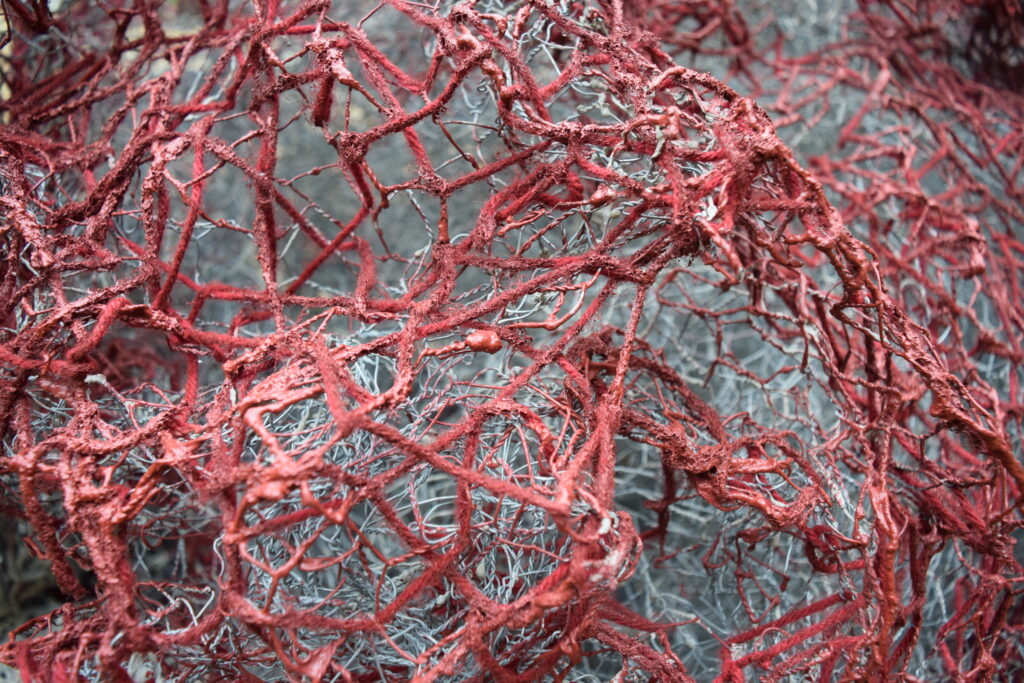
TBE
What were some of the most interesting or powerful or moving reactions, or even surprising reactions, that you’ve seen as you share this artwork?
CT
On the day of the installation, I was there in overalls installing the piece downtown. Two things happened, separated by one hour, which give me goosebumps. I’m there installing, I’m dirty, my hands are covered in concrete. And this old woman comes along shuffling with a walker and stops at the piece, and she’s looking and looking and looking. And I’m working and I can tell that she’s very interested in the piece. And so I approached her and she said to me, Can you tell me a little bit about this? I said I’m the artist. And so we start talking. And her eyes well up. And she says to me: “My husband was a Holocaust survivor from Auschwitz. And thank you so much for doing this.” And she starts to cry. She lost her husband, and her husband also had a number on his arm.
Not even an hour later, an older woman who looks beautifully dressed comes by, again stops and is staring. And I approached her and started talking. She said, “I was a young girl in Paris during the Holocaust. My family was all separated. We each went a different way. We were sent away to South of France. And my mother’s family didn’t make it. A yellow star in the middle of Boston, that is just,” and she starts to cry. So do I. And she said to me, “Eisenhower told the troops when they got to the camps to take a lot of photos, because one day people will deny that this ever happened.” And, I mean, I get goosebumps just thinking about it. Eisenhower was right. And we’re still doing the work and antisemitism is alive. And so it’s just like the proof is in the pudding. We need to make more art about this. We need to talk about this.
TBE
Especially in the past few months, it feels like this is particularly urgent work. And you’ve been working on this project for how long?
CT
Two years.
TBE
Two years. So what is it like to have now be the time that it’s out in the public?
CT
You know, it’s unbelievable that this is now, but antisemitism is here to stay. We know that it’s not going anywhere. In fact, just rising. So I think the fact that we haven’t been talking about this before is what’s catching us now by surprise. I think there’s still a legitimate sense that it’s open season on the Jews right now. And that’s what it feels like. So it’s kind of amazing that the timing coincided, but the sentiment has always been there.
TBE
Antisemitism is something that perhaps our community is always thinking about, even though it’s not always as prominent in the news. What did it mean to you to have the piece be in the Fenway? And what does it mean to you to have it at TBE now? What kind of responsibility do we have as a community in how we interact with it?
CT
So for a long time, after I installed the piece, I would sit at Sweetgreen, which is just across like around the corner, and sit there and watch people as they walked by and interacted with the piece. And it felt quite amazing to have a piece that has a yellow star and Hebrew text in the Fenway. That was my point: that we elevate the conversation, and we bring it out to the public, this was part of what we need to do. So that was amazing.
When we put it down in the courtyard at TBE, I had serious chills. I felt like first of all, it had arrived home. There was a deep sense of pride that I was able to put that piece where it is right now. That you can sit in the sanctuary and look inward and outward and think about what we have survived as a community. And so there’s almost like this inside, outside thing. Inside where we’re a thriving community with so much to offer the world, and yet on the outside… So it’s both the physical and the metaphorical here that comes into play. It’s very profound for me, it feels like the message is so universal, but the story is so personal. I really am full of gratitude to all that the community that is taking on issues like this in a serious way.
I also think that for us as a community to look forward, we always have to look back. We always have to remember what it is that came before us so that we can be a better community. So that we can be inclusive, so that we can welcome the stranger, so that we can be different from those who dehumanize us. And I think TBE looks at that all the time. Looking back to look forward is such a core part of who we are that this placement is perfect for the piece.
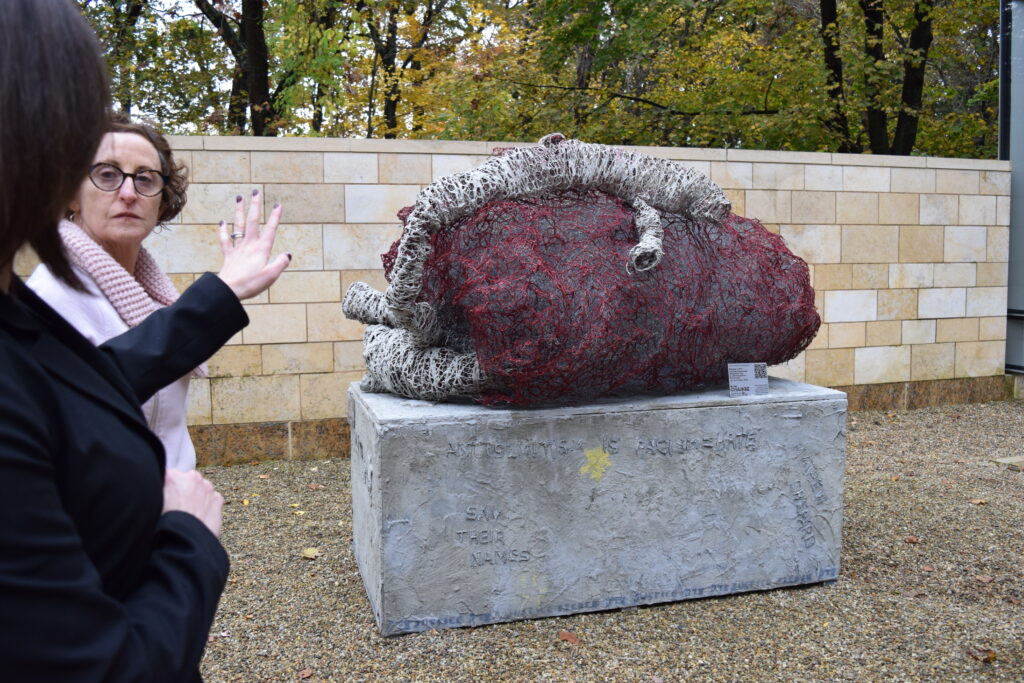
TBE
The BE THE CHANGE project originated with your work and your conversations, and now it’s a project that’s across the country. What does it feel like to be working as an artist and an activist on this scale?
CT
I never in my wildest dreams imagined that it would be this, and then it’s going to be even more. I mean, it’s quite amazing, but it also indicates how engaged we are as a community in these issues that are still deep in the Jewish psyche. The Jewish psyche is this idea of Be the Change, and that we are a faith that does justice. And it’s not surprising, but it is absolutely amazing that it’s going to have this incredible life of its own.
TBE
And the artists who have been commissioned to create work all across the country, everyone picked their own issue [to engage with in an artistic way]. Have you heard about the different conversations coming up? Or, how have you kind of seen the project come to life across the country?
CT
Each artist picked a theme that was close to their heart, which makes the work very authentic. And what makes it so powerful is that the issues are so much a part of each artist’s core identity. We spent time studying together with Ruth Messinger and with Rabbi Sharon Anisfeld, and non-Jewish artists understand the theme of tzedek and tzedakah in the most authentic way.
It’s wonderful to see the exposure that the artists have received. Nayana LaFond now has a commission for Burning Man as a result of this piece. Jason Talbot’s piece sold to a Jewish collective. So this idea that we’re not only talking about issues, but we’re also lifting up others through Jewish art is part of my artivism. So we’re lifting others through this art, offering exposure that, if it wasn’t for this project, it might not have received or it might have taken much longer to get there. It’s kind of exciting to see how this all comes together, and the impact that it’s had on the artists.
TBE
With art and activism, how do you know what your work is doing? How do you know your activism is making change?
CT
That’s a good question. I don’t know. I’d like to believe that it is. I can’t quantify it. I know anecdotally that it is bringing people into conversations that they might not have been engaged in. I know for a fact that it’s lifting other artists. I know that we are bringing Jewish art into a mainstream space. And I know from how people have responded—I have so many different emails and texts from people who’ve told me that it’s touched them or that it’s impacted them, that they’ve engaged in conversations that they might not have been engaged in.
And I can tell you a story. In a recent show, Humanity is Not a Spectator Sport, I had my birth certificate on the wall next to a piece that was titled “Human.” And I was giving a tour to a group and talking about my birth certificate, about my white privilege of being born in a white Hospital in in apartheid South Africa. And down the road, there was another woman, a Black woman who’s delivering a baby, probably in a shack, and without proper proper medical care, and how that’s made me think about my own privilege. And a woman raises her hand in and says to me: I am that Black child and thank you for talking about this. So I couldn’t hope for more than that. That is what my art is hoping to do.
TBE
From those personal, intimate interactions that it sparks all the way through to knowing that your ideas and work have elevated the voices of other people, and really brought these topics into the public sphere, it’s exciting and really amazing to learn about your work. Thank you for spending this time answering our questions. One last question: Is there anything that you want the TBE community to know that we didn’t ask specifically?
CT
First of all, that I’m always happy to talk about my art. Always, always, happy to talk about that. That I’m incredibly grateful to be part of a community that asks these questions that engages with these issues that grapples with its place and responsibility in the world. To me, it feels like home in that way. And for that, I’m very grateful.
